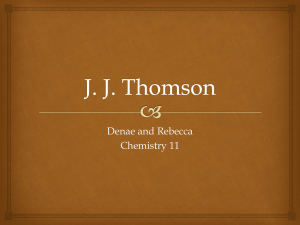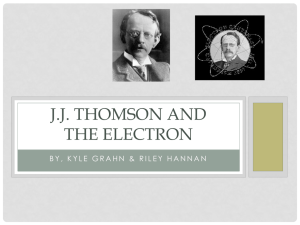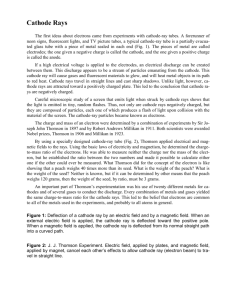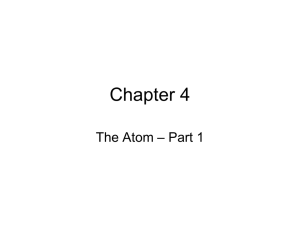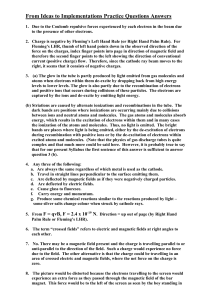Structure of Atom
advertisement
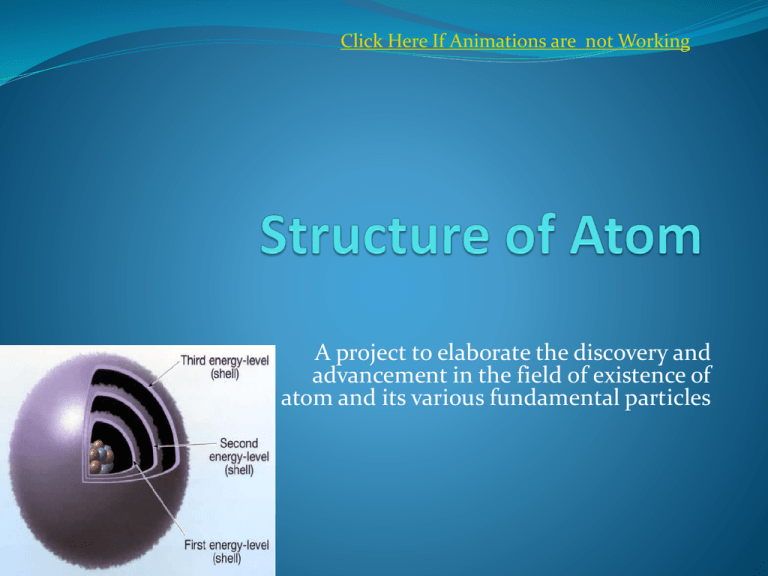
Click Here If Animations are not Working A project to elaborate the discovery and advancement in the field of existence of atom and its various fundamental particles Click Here If Animations are not Working After this animation you will be able to Know more about the discovery of electron , proton and neutron. Thomson, Rutherford and Bohr atomic models. Rutherford’s Alpha scattering experiment. Quantum mechanical model of atom. Photoelectric effect. Click Here If Animations are not Working Discovery of atom The existence of atom has been proposed since the time of early Indian and Greek philosophers(400 B.C.) who were of the view that atoms are the fundamental building blocks of matter. The word atom has been derived from the Greek word “a-tomio” which means uncut able or non-divisible. These ideas remain dormant for a very long time and were revived again by scientists in nineteenth century. Scientists work hard to discover the sub-atomic particles and those experiments are as…. Click Here If Animations are not Working Discharge Tube Experiment Click here to play William Crooks performed this exp. In cylindrical glass tube as shown in figure. Observations : 1. No current flows at 1 atm pressure even at high voltage (about 104 V ) 2. When pressure is reduced to 10-2 atm, gas is found to emit light which depends upon the nature of gas. 3. Further decrease in pressure stops emission of light but walls opposite to cathode starts glowing and this is called fluorescence. Result : Fluorescence is due to rays emitted from cathode and hence these rays are called cathode rays. Click Here If Animations are not Working Properties of cathode ray J.J.Thomson studied the important properties of cathode rays as follows: Click The Following To Study : Cathode rays travel in a straight line . Cathode rays are made up of material particles. Cathode rays consists of negatively charged particles. Click Here If Animations are not Working Discovery of electrons As cathode rays are made up of material particles which are attracted towards the positively charged plate. So , cathode rays consists of negatively charged particles and they were named as Electrons. As J.J.Thomson studied the properties of cathode rays which led to the discovery of electrons so, its J.J. Thomson who discovered electrons Click Here If Animations are not Working Discovery of Protons( Anode Rays) In 1886, Goldstein performed discharge tube experiment with certain modifications as shown in figure. He observed new type of luminous rays passing through perforations of cathode and moving in directions opposite to cathode rays. So, these rays consists of positively charged particles called Protons and these rays are called Anode rays. Anode rays are not emitted from anode but from a space between anode and cathode. Click Here If Animations are not Working J.J. Thomson model of Atom In 1904, Thomson proposed that atom is a sphere of positively charged particles in which negatively charged electrons are embedded. Stability of atom was explained on the basis of attraction between positively and negatively charged protons and electrons respectively. Drawbacks: One major drawback is that it could not explained the Rutherford’s Alpha Scattering Experiment , hence rejected. Click Here If Animations are not Working Rutherford’s α-Scattering Experiment Click Here To See Experiment And Its Results Observation: Most of the α-particles passed through the gold foil. 2. A small fraction of α-particles was deflected by small angles. 3. A very few α-particles (~1 in 20,000)bounced back, that is, were deflected by nearly 1800. 1. For Conclusions Click Here Click Here If Animations are not Working Drawbacks of Rutherford’s Model Of An Atom His model cannot explain the hydrogen atomic spectra and of other elements. When an electron revolves in a orbit the it undergoes acceleration and due to which it looses energy and hence ultimately fall into the nucleus. But actually this does not happened so his model is not appropriate. Click Here If Animations are not Working Planck Quantum Theory After the failure of Electromagnetic wave theory, Max.Planck came into picture and gives few postulates as: 1. Radiant energy is emitted or absorbed not continuously but discontinuously in the form of packets called Quantum. & these quantum a re called Photons in case of light. 2. Energy of each quantum is directly proportional to the frequency of radiation. i.e. E ∞ V or E = hv where h is planks constant such that h = 6.626 X 10-34 J/s 3. Total amount of energy emitted is whole number multiple of quantum , i.e. E = nhv where n in any natural number Click Here If Animations are not Working Photoelectric effect Click Here To see photoelectric effect DEFINITION : The ejection of electrons from the surface of a metal under the influence of striking photons . EXPLANATION : Actually electrons are held by the nuclei by some force called Binding Energy. But photons which fall on the carries energy and hence excite them to the surface from where electrons start moving in a definite direction with definite amount of kinetic energy. CONDITIONS : Energy of incident photons = Work Function + Kinetic Energy of electron hυ = hυ0 + ½ mv2 Click Here If Animations are not Working Bohr’s Model Of An Atom Click Here to view Bohr’s Model of an Atom Whole mass of atom is present in the central core called nucleus. Electrons revolve around the nucleus in stationary orbits also called energy levels. Angular momentum of an electron in a given stationary orbit can be given by mvr = nh/2π No. of electrons in a given energy level is given by No of electrons = 2n2 Click Here If Animations are not Working Failures Of Bohr’s Model The theory could not explain the atomic spectra of atoms containing more than one electrons. Theory failed to explain the fine structure of spectral lines. Splitting of lines in the magnetic field is known as Zeeman Effect and splitting of lines in the electric field is known as Stark Effect. Bohr’s theory could not offer any satisfactory explanation of these effects. Theory failed to explain the shapes of the molecules formed by the combination of atoms. Bohr’s Theory could not explain the de Broglie’s Relationship and Heisenberg’s Uncertainty Principle. Click Here If Animations are not Working De Broglie Concept Click here to see the prove He stated that moving particles are associated with dual nature i.e. wave and particle nature. He co-related the two characters in the form of an equation known as de-Broglie Equation. λ = h/mv Heisenberg’s Uncertainty Principle He stated that, It is not possible to measure simultaneously the position and the momentum of a microscopic particle with absolute accuracy or certainty. Mathematically, ∆x.∆p = h/4π This principle is a prove that electron can never exists inside the nucleus. Click Here If Animations are not Working Quantum Mechanical Model Of An Atom It is found that instead of revolving in an orbit electrons actually revolve in orbital and these orbital aggregate to form orbits. To know more Click Here



